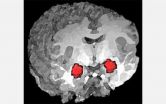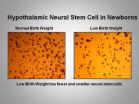(Press-News.org) A new study sheds light--both literally and figuratively--on the intricate brain cell connections responsible for anxiety.
Scientists at Stanford University recently used light to activate mouse neurons and precisely identify neural circuits that increase or decrease anxiety-related behaviors. Pinpointing the origin of anxiety brings psychiatric professionals closer to understanding anxiety disorders, the most common class of psychiatric disease.
A research team led by Karl Deisseroth, associate professor of psychiatry and behavioral sciences and bioengineering, identified two key pathways in the brain: one which promotes anxiety, and one which alleviates anxiety.
The pathways are in a brain region called the amygdala. Prior research suggests the amygdala plays a role in anxiety, but earlier studies used widespread modifications of the amygdala, through drugs or physical disruption of the brain region, to study the way in which it affects anxiety. This new work, published in this week's Nature, uses a tool called optogenetics--developed by Deisseroth and recently named Method of the Year by Nature Methods--to specifically tease out which pathways contribute to anxiety.
Optogenetics combines genetics and optical science to selectively manipulate the way a neuron fires in the brain. Neurons are electrically excitable cells that convey information through electrical and chemical signaling.
Directed genetic manipulations cause specific neurons to assemble a light-activated protein normally found in algae and bacteria. When triggered by certain wavelengths of light, these proteins allow researchers to increase or decrease neuronal activity in the brain and observe the effects on rodent models in an experiment.
Using optogenetic manipulation of various amygdala pathways, Deisseroth and colleagues examined how mouse behavior was affected. Since mice display anxiety-related behaviors in open spaces, they measured changes in anxiety by analyzing how much time mice spent exploring the center of an open field, or exploring the length of a platform without walls.
While optogenetics has been used to study amygdala function in behaviorally-conditioned fear, this is the first time it has been used to study anxiety. "Fear and anxiety are different," Deisseroth explained. "Fear is a response to an immediate threat, but anxiety is a heightened state of apprehension with no immediate threat. They share the same outputs, for example physical manifestations such as increased heart rate, but their controls are very different."
Anxiety disorders are the most prevalent among all psychiatric diseases, and include diseases such as post-traumatic stress disorder, obsessive-compulsive disorder and phobias. Anxiety also contributes to other major psychiatric disorders such as depression and substance abuse.
"Now that we know that these cell projections [in the amygdala] exist, we can first use this knowledge to understand anxiety more than we do now," Deisseroth noted.
Deisseroth has previously used optogenetics to study deep brain stimulation in Parkinson's disease. This research was detailed last year in the journal Science and reported online by the National Science Foundation (NSF).
"Deep brain stimulation is increasingly being considered for psychiatric disorders, so after studying Parkinson's disease, we started building towards research on psychiatric disorders," Deisseroth commented. Next he wants to use these tools to study depression and autism spectrum disorders.
INFORMATION:
Groundwork for the optogenetics technique was funded by NSF. This research was supported by the National Alliance for Research on Schizophrenia and Depression, the National Institutes of Health and NSF.
Researchers selectively control anxiety pathways in the brain
Study uses NSF-supported technology to identify neuronal circuitry
2011-03-10
ELSE PRESS RELEASES FROM THIS DATE:
Researchers develop synthetic compound that may lead to drugs to fight pancreatic, lung cancer
2011-03-10
DALLAS – March 10, 2011 – Researchers at UT Southwestern Medical Center have identified a chemical compound that may eventually lead to a drug that fights cancers that are dependent on a particular anti-viral enzyme for growth.
The researchers are testing the compound's effectiveness at fighting tumors in mice. If it is successful, they will then work to develop a drug based on the compound to combat pancreatic and non-small cell lung cancer, two cancer types in which this particular enzyme, TBK-1, often is required for cancer cell survival.
"Our prediction is that ...
Report: International collaboration between researchers results in greater recognition
2011-03-10
U.S. researchers who collaborate with international scientists are more likely to have their work cited than peers who do not utilize overseas expertise, according to a new study released this week by Rice University's Baker Institute for Public Policy. U.S. collaborators with international scientists are also more likely to receive greater recognition and produce work with greater impact.
The study, "International Stem Cell Collaboration: How Disparate Policies Between the United States and the United Kingdom Impact Research," was authored by Kirstin Matthews, a fellow ...
New UF study shows some sharks follow 'mental map' to navigate seas
2011-03-10
GAINESVILLE, Fla. — A new study led by a University of Florida researcher uses tracking data of three shark species to provide the first evidence some of the fish swim directly to targeted locations.
Researchers found tiger and thresher sharks showed the ability to orient at large distances, with tiger sharks swimming in direct paths at least 4 miles away and reaching specific resource areas about 30 miles away, said lead author Yannis Papastamatiou, a marine biologist in the division of ichthyology at the Florida Museum of Natural History on the UF campus.
A research ...
Researchers identify new biomarker for Creutzfeldt-Jakob disease, the human form of mad cow disease
2011-03-10
Neena Singh, MD, PhD and colleagues at Case Western Reserve University School of Medicine have identified the first disease-specific biomarker for sporadic Creutzfeldt-Jakob disease (sCJD), a universally fatal, degenerative brain disease for which there is no cure. sCJD is one of the causes of dementia and typically leads to death within a year of disease onset.
The finding, published in the March 9th issue of PLoS ONE, a scientific journal produced by the Public Library of Science, provides a basis for developing a test to diagnosis sCJD while patients are still alive. ...
Nottingham scientists identify trigger in cat allergy
2011-03-10
A breakthrough by scientists at The University of Nottingham could provide hope for any allergy sufferers who have ever had to choose between their health and their household pet.
The team of immunologists led by Drs Ghaem-Maghami and Martinez-Pomares in the University's School of Molecular Medical Sciences, and funded by the charity Asthma UK, have identified a cell component which plays a key role in triggering allergic responses to cat dander.
The discovery furthers our understanding of how the body's immune system identifies and reacts to allergens, which could ...
Passive smoking increases risk to unborn babies, study says
2011-03-10
Pregnant non-smokers who breathe in the second-hand smoke of other people are at an increased risk of delivering stillborn babies or babies with defects, a study led by researchers at The University of Nottingham has found.
The study, published in the April edition of the journal Pediatrics, found passive smoking increased the risk of still birth by almost one-quarter (23 per cent) and was linked to a 13 per cent increased risk of congenital birth defects.
The findings underline the importance of discouraging expectant fathers from smoking around their pregnant partners ...
Hopkins Children's study finds some patients with cerebral palsy have asymmetric pelvic bones
2011-03-10
Johns Hopkins Children's Center researchers have discovered that most children with severe cerebral palsy have starkly asymmetric pelvic bones. The newly identified misalignment can affect how surgeries of the pelvis, spine and surrounding structures are performed, the researchers say.
The study will be published online on March 10 in the Journal of Pediatric Orthopaedics.
Previous studies of patients with cerebral palsy have reported asymmetry above the pelvis and misalignment of the hips, but this new report, the researchers say, is the first one to show misalignment ...
Brandeis researchers use lasers, custom microscope to show gene splicing process in real time
2011-03-10
From neurosurgery to bar code readers, lasers have been used in a myriad of applications since they were first introduced in the late 1950's. Now, with the work being done in Jeff Gelles' Lab at Brandeis University, researchers have developed a way to use lasers to study the splicing of pre-messenger RNA molecules, an essential process in creating proteins to sustain advanced organisms, including human life. This process of splicing is carried out by a cellular micro-machine called the spliceosome.
"Understanding how these micro-machines function inside the cell is important ...
Study provides explanation for connection between low birth weight and obesity later in life
2011-03-10
Providing further understanding of the link between low birth weights and obesity later in life, researchers found nutritionally deprived newborns are "programmed" to eat more because they develop less neurons in the region of the brain that controls food intake, according to an article published today in the journal, Brain Research.
The study by a team of researchers at Los Angeles Biomedical Research Institute at Harbor-UCLA Medical Center (LA BioMed) suggests that overeating is programmed at the level of stem cells before birth when the mother has poor or inadequate ...
Aegis Global Software Used Microsoft Silverlight To Provide Consistent Microsoft Solutions
2011-03-10
At Aegis, we are always on the forefront of using the latest technologies to create different types of applications and we would like to give an overview of the new technology from Microsoft called Silverlight. Silverlight is a comprehensive development platform that assist in the creation of interactive applications that may be web based, for desktops or even mobile handsets. Silverlight is a kind of free plugin and since it is based on .Net framework therefore it compatible across various operating systems, browsers and platforms. In a way Silverlight frees any kind of ...
LAST 30 PRESS RELEASES:
Satellite data helps UNM researchers map massive rupture of 2025 Myanmar earthquake
Twisting Spins: Florida State University researchers explore chemical boundaries to create new magnetic material
Mayo Clinic researchers find new hope for toughest myeloma through off-the-shelf immunotherapy
Cell-free DNA Could Detect Adverse Events from Immunotherapy
American College of Cardiology announces Fuster Prevention Forum
AAN issues new guideline for the management of functional seizures
Could GLP-1 drugs affect risk of epilepsy for people with diabetes?
New circoviruses discovered in pilot whales and orcas from the North Atlantic
Study finds increase in risk of binge drinking among 12th graders who use 2 or more cannabis products
New paper-based technology could transform cancer drug testing
Opioids: clarifying the concept of safe supply to save lives
New species of tiny pumpkin toadlet discovered in Brazil highlights need for conservation in the mountain forests of Serra do Quiriri
Reciprocity matters--people were more supportive of climate policies in their country if they believed other countries were making significant efforts themselves
Stanford Medicine study shows why mRNA-based COVID-19 vaccines can cause myocarditis
Biobanking opens new windows into human evolution
Sky-high smoke
AI tips off scientists to new drug target to fight, treat mpox
USC researchers develop next-generation CAR T cells that show stronger, safer response in animal models
New study reveals Industrial Revolution’s uneven health impacts across England
Vine-inspired robotic gripper gently lifts heavy and fragile objects
Fingerprint of ancient seafarer found on Scandinavia’s oldest plank boat
Lunar soil analyses reveal how space weathering shapes the Moon’s ultraviolet reflectance
Einstein’s theory comes wrapped up with a bow: astronomers spot star “wobbling” around black hole
Danforth Plant Science Center to lead multi-disciplinary research to enhance stress resilience in bioenergy sorghum
Home-delivered groceries improve blood sugar control for people with diabetes facing food insecurity
MIT researchers identified three cognitive skills we use to infer what someone really means
The Iberian Peninsula is rotating clockwise according to new geodynamic data
SwRI, Trinity University to study stable bacterial proteins in search of medical advances
NIH-led study reveals role of mobile DNA elements in lung cancer progression
Stanford Medicine-led study identifies immune switch critical to autoimmunity, cancer
[Press-News.org] Researchers selectively control anxiety pathways in the brainStudy uses NSF-supported technology to identify neuronal circuitry


